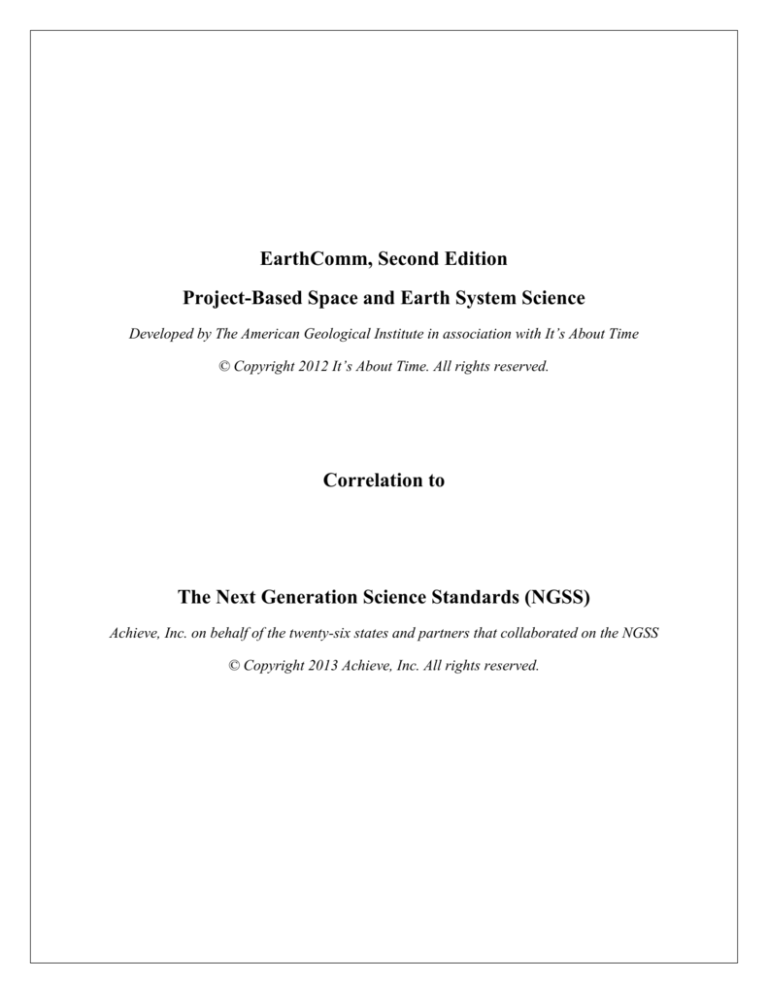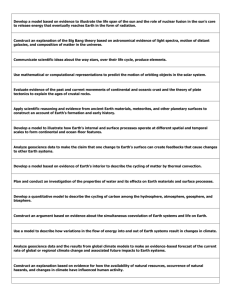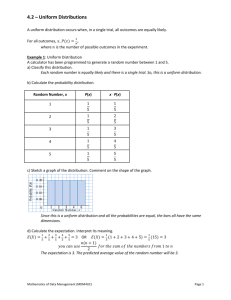
EarthComm, Second Edition
Project-Based Space and Earth System Science
Developed by The American Geological Institute in association with It’s About Time
© Copyright 2012 It’s About Time. All rights reserved.
Correlation to
The Next Generation Science Standards (NGSS)
Achieve, Inc. on behalf of the twenty-six states and partners that collaborated on the NGSS
© Copyright 2013 Achieve, Inc. All rights reserved.
EarthComm, 2nd Edition (EC) and Next Generation Science Standards (NGSS)
Correlation of EC Sections to NGSS Standards
Chapter 1 Astronomy
EarthComm Section 1 The Size and Scale of the Universe
Section
Correlating HS-ESS1-4. Use mathematical or computational representations to predict the
Performance motion of orbiting objects in the solar system.
Expectation
EarthComm Section 2 Locating Astronomical Objects in the Night Sky
Section
Correlating HS-ESS1-4. Use mathematical or computational representations to predict the
Performance motion of orbiting objects in the solar system.
Expectation
EarthComm
Section
Correlating
Performance
Expectation
Section 3 Origin of the Universe and the Solar System
HS-ESS1-2. Construct an explanation of the Big Bang theory based on
astronomical evidence of light spectra, motion of distant galaxies, and
composition of matter in the universe.
HS-ESS1-6. Apply scientific reasoning and evidence from ancient Earth
materials, meteorites, and other planetary surfaces to construct an account of
Earth’s formation and early history.
EarthComm Section 4 Orbits and Effects
Section
Correlating HS-ESS1-4. Use mathematical or computational representations to predict the
Performance motion of orbiting objects in the solar system.
Expectation
EarthComm
Section
Correlating
Performance
Expectation
Section 5 The Sun-Earth-Moon System
HS-ESS1-4. Use mathematical or computational representations to predict the
motion of orbiting objects in the solar system.
HS-ESS1-6. Apply scientific reasoning and evidence from ancient Earth
materials, meteorites, and other planetary surfaces to construct an account of
Earth’s formation and early history.
2
EarthComm, 2nd Edition (EC) and Next Generation Science Standards (NGSS)
Correlation of EC Sections to NGSS Standards
EarthComm
Section
Correlating
Performance
Expectation
Section 6 Impact Events and the Earth System
EarthComm
Section
Correlating
Performance
Expectation
Section 7 The Electromagnetic Spectrum
EarthComm
Section
Correlating
Performance
Expectation
Section 8 The Sun and its Effects
EarthComm
Section
Correlating
Performance
Expectation
Section 9 The Lives of Stars
HS-ESS1-6. Apply scientific reasoning and evidence from ancient Earth
materials, meteorites, and other planetary surfaces to construct an account of
Earth’s formation and early history.
HS-ESS1-1. Develop a model based on evidence to illustrate the life span of the
sun and the role of nuclear fusion in the sun’s core to release energy in the form
of radiation.
HS-ESS1-1. Develop a model based on evidence to illustrate the life span of the
sun and the role of nuclear fusion in the sun’s core to release energy in the form
of radiation.
HS-ESS1-1. Develop a model based on evidence to illustrate the life span of the
sun and the role of nuclear fusion in the sun’s core to release energy in the form
of radiation.
HS-ESS1-3. Communicate scientific ideas about the way stars, over their life
cycle, produce elements.
3
EarthComm, 2nd Edition (EC) and Next Generation Science Standards (NGSS)
Correlation of EC Sections to NGSS Standards
Chapter 2 Plate Tectonics
EarthComm
Section
Correlating
Performance
Expectation
Section 1 Where are the Volcanoes and Earthquakes?
EarthComm
Section
Correlating
Performance
Expectation
Section 2 Earth’s Moving Lithospheric Plates
EarthComm
Section
Correlating
Performance
Expectation
Section 3 What Drives the Plates?
EarthComm
Section
Correlating
Performance
Expectation
Section 4 Plate Motions and Plate Interactions
EarthComm
Section
Correlating
Performance
Expectation
Section 5 Plate Boundary Environments
HS-ESS2-1. Develop a model to illustrate how Earth’s internal and surface
processes operate at different spatial and temporal scales to form continental and
ocean-floor features.
HS-ESS2-3. Develop a model based on evidence of Earth’s interior to describe
the cycling of matter by thermal convection.
HS-ESS2-1. Develop a model to illustrate how Earth’s internal and surface
processes operate at different spatial and temporal scales to form continental and
ocean-floor features.
HS-ESS2-3. Develop a model based on evidence of Earth’s interior to describe
the cycling of matter by thermal convection.
HS-ESS2-1. Develop a model to illustrate how Earth’s internal and surface
processes operate at different spatial and temporal scales to form continental and
ocean-floor features.
HS-ESS2-3. Develop a model based on evidence of Earth’s interior to describe
the cycling of matter by thermal convection.
HS-ESS1-5. Evaluate evidence of the past and current movements of continental
and oceanic crust and the theory of plate tectonics to explain the ages of crustal
rocks.
HS-ESS2-1. Develop a model to illustrate how Earth’s internal and surface
processes operate at different spatial and temporal scales to form continental and
ocean-floor features.
HS-ESS1-5. Evaluate evidence of the past and current movements of continental
and oceanic crust and the theory of plate tectonics to explain the ages of crustal
rocks.
4
EarthComm, 2nd Edition (EC) and Next Generation Science Standards (NGSS)
Correlation of EC Sections to NGSS Standards
HS-ESS2-1. Develop a model to illustrate how Earth’s internal and surface
processes operate at different spatial and temporal scales to form continental and
ocean-floor features.
EarthComm
Section
Correlating
Performance
Expectation
Section 6 The Changing Geography of Your Community
EarthComm
Section
Correlating
Performance
Expectation
Section 7 Volcanic Landforms
EarthComm
Section
Correlating
Performance
Expectation
Section 8 Volcanic Hazards: Flows
EarthComm
Section
Correlating
Performance
Expectation
Section 9 Volcanoes and the Atmosphere
EarthComm
Section
Correlating
Section 10 Earthquakes
HS-ESS1-5. Evaluate evidence of the past and current movements of continental
and oceanic crust and the theory of plate tectonics to explain the ages of crustal
rocks.
HS-ESS2-1. Develop a model to illustrate how Earth’s internal and surface
processes operate at different spatial and temporal scales to form continental and
ocean-floor features.
HS-ESS2-1. Develop a model to illustrate how Earth’s internal and surface
processes operate at different spatial and temporal scales to form continental and
ocean-floor features.
HS-ESS3-1. Construct an explanation based on evidence for how the
availability of natural resources, occurrence of natural hazards, and changes in
climate have influenced human activity.
HS-ESS2-2. Analyze geoscience data to make the claim that one change to
Earth's surface can create feedbacks that cause changes to other Earth systems.
HS-ESS2-4. Use a model to describe how variations in the flow of energy into
and out of Earth’s systems result in changes in climate.
HS-ESS2-6. Develop a quantitative model to describe the cycling of carbon
among the hydrosphere, atmosphere, geosphere, and biosphere.
HS-ESS3-1. Construct an explanation based on evidence for how the
availability of natural resources, occurrence of natural hazards, and changes in
climate have influenced human activity.
HS-ESS2-3. Develop a model based on evidence of Earth’s interior to describe
5
EarthComm, 2nd Edition (EC) and Next Generation Science Standards (NGSS)
Correlation of EC Sections to NGSS Standards
Performance the cycling of matter by thermal convection.
Expectation
EarthComm Section 11 Detecting Earthquake Waves
Section
Correlating HS-ESS2-3. Develop a model based on evidence of Earth’s interior to describe
Performance the cycling of matter by thermal convection.
Expectation
EarthComm
Section
Correlating
Performance
Expectation
Section 12 Earthquake Magnitude
HS-ESS3-1. Construct an explanation based on evidence for how the
availability of natural resources, occurrence of natural hazards, and changes in
climate have influenced human activity.
6
EarthComm, 2nd Edition (EC) and Next Generation Science Standards (NGSS)
Correlation of EC Sections to NGSS Standards
Chapter 3 Minerals, Rocks, and Structures
EarthComm
Section
Correlating
Performance
Expectation
Section 1 What Are Minerals?
EarthComm
Section
Correlating
Performance
Expectation
Section 2 Igneous Rocks and the Geologic History or Your Community
EarthComm
Section
Correlating
Performance
Expectation
Section 3 Sedimentary Rocks and the Geologic History of Your Community
EarthComm
Section
Section 4 Metamorphic Rocks and the Geologic History of Your
Community
HS-ESS1-5. Evaluate evidence of the past and current movements of continental
and oceanic crust and the theory of plate tectonics to explain the ages of crustal
rocks.
HS-ESS1-5. Evaluate evidence of the past and current movements of continental
and oceanic crust and the theory of plate tectonics to explain the ages of crustal
rocks.
HS-ESS2-3. Develop a model based on evidence of Earth’s interior to describe
the cycling of matter by thermal convection.
HS-ESS2-5. Plan and conduct an investigation of the properties of water and its
effects on Earth materials and surface processes.
HS-ESS1-5. Evaluate evidence of the past and current movements of continental
and oceanic crust and the theory of plate tectonics to explain the ages of crustal
rocks.
HS-ESS2-5. Plan and conduct an investigation of the properties of water and its
effects on Earth materials and surface processes.
Correlating HS-ESS1-5. Evaluate evidence of the past and current movements of continental
Performance and oceanic crust and the theory of plate tectonics to explain the ages of crustal
Expectation rocks.
EarthComm
Section
Correlating
Performance
Expectation
Section 5 Rock Units and Your Community
HS-ESS1-5. Evaluate evidence of the past and current movements of continental
and oceanic crust and the theory of plate tectonics to explain the ages of crustal
rocks.
7
EarthComm, 2nd Edition (EC) and Next Generation Science Standards (NGSS)
Correlation of EC Sections to NGSS Standards
EarthComm
Section
Correlating
Performance
Expectation
Section 6 Structural Geology and Your Community
EarthComm
Section
Correlating
Performance
Expectation
Section 7 Reading the Geologic History of Your Community
HS-ESS1-5. Evaluate evidence of the past and current movements of continental
and oceanic crust and the theory of plate tectonics to explain the ages of crustal
rocks.
HS-ESS1-5. Evaluate evidence of the past and current movements of continental
and oceanic crust and the theory of plate tectonics to explain the ages of crustal
rocks.
EarthComm Section 8 Geology of the United States
Section
Correlating HS-ESS1-5. Evaluate evidence of the past and current movements of continental
Performance and oceanic crust and the theory of plate tectonics to explain the ages of crustal
Expectation rocks.
8
EarthComm, 2nd Edition (EC) and Next Generation Science Standards (NGSS)
Correlation of EC Sections to NGSS Standards
Chapter 4 Surface Processes
EarthComm
Section
Correlating
Performance
Expectation
Section 1 The Water Cycle
EarthComm
Section
Correlating
Performance
Expectation
Section 2 Rivers and Drainage Basins
EarthComm
Section
Correlating
Performance
Expectation
Section 3 Slopes and Landscapes
EarthComm
Section
Correlating
Performance
Expectation
Section 4 High-Gradient Streams
HS-ESS2-1. Develop a model to illustrate how Earth’s internal and surface
processes operate at different spatial and temporal scales to form continental and
ocean-floor features.
HS-ESS2-2. Analyze geoscience data to make the claim that one change to
Earth's surface can create feedbacks that cause changes to other Earth systems.
HS-ESS2-5. Plan and conduct an investigation of the properties of water and its
effects on Earth materials and surface processes.
HS-ESS2-1. Develop a model to illustrate how Earth’s internal and surface
processes operate at different spatial and temporal scales to form continental and
ocean-floor features.
HS-ESS2-2. Analyze geoscience data to make the claim that one change to
Earth's surface can create feedbacks that cause changes to other Earth systems.
HS-ESS2-5. Plan and conduct an investigation of the properties of water and its
effects on Earth materials and surface processes.
HS-ESS2-1. Develop a model to illustrate how Earth’s internal and surface
processes operate at different spatial and temporal scales to form continental and
ocean-floor features.
HS-ESS2-2. Analyze geoscience data to make the claim that one change to
Earth's surface can create feedbacks that cause changes to other Earth systems.
HS-ESS2-5. Plan and conduct an investigation of the properties of water and its
effects on Earth materials and surface processes.
HS-ESS3-1. Construct an explanation based on evidence for how the
availability of natural resources, occurrence of natural hazards, and changes in
climate have influenced human activity.
HS-ESS2-1. Develop a model to illustrate how Earth’s internal and surface
processes operate at different spatial and temporal scales to form continental and
ocean-floor features.
9
EarthComm, 2nd Edition (EC) and Next Generation Science Standards (NGSS)
Correlation of EC Sections to NGSS Standards
HS-ESS2-2. Analyze geoscience data to make the claim that one change to
Earth's surface can create feedbacks that cause changes to other Earth systems.
HS-ESS2-5. Plan and conduct an investigation of the properties of water and its
effects on Earth materials and surface processes.
HS-ESS3-1. Construct an explanation based on evidence for how the
availability of natural resources, occurrence of natural hazards, and changes in
climate have influenced human activity.
EarthComm
Section
Correlating
Performance
Expectation
Section 5 Low-Gradient Streams
EarthComm
Section
Correlating
Performance
Expectation
Section 6 Sediments in Streams
EarthComm
Section
Correlating
Performance
Expectation
Section 7 Soil and Land Use
HS-ESS2-1. Develop a model to illustrate how Earth’s internal and surface
processes operate at different spatial and temporal scales to form continental and
ocean-floor features.
HS-ESS2-2. Analyze geoscience data to make the claim that one change to
Earth's surface can create feedbacks that cause changes to other Earth systems.
HS-ESS2-5. Plan and conduct an investigation of the properties of water and its
effects on Earth materials and surface processes.
HS-ESS2-1. Develop a model to illustrate how Earth’s internal and surface
processes operate at different spatial and temporal scales to form continental and
ocean-floor features.
HS-ESS2-2. Analyze geoscience data to make the claim that one change to
Earth's surface can create feedbacks that cause changes to other Earth systems.
HS-ESS2-5. Plan and conduct an investigation of the properties of water and its
effects on Earth materials and surface processes.
HS-ESS2-1. Develop a model to illustrate how Earth’s internal and surface
processes operate at different spatial and temporal scales to form continental and
ocean-floor features.
HS-ESS2-2. Analyze geoscience data to make the claim that one change to
Earth's surface can create feedbacks that cause changes to other Earth systems.
HS-ESS2-5. Plan and conduct an investigation of the properties of water and its
effects on Earth materials and surface processes.
HS-ESS3-1. Construct an explanation based on evidence for how the
availability of natural resources, occurrence of natural hazards, and changes in
climate have influenced human activity.
10
EarthComm, 2nd Edition (EC) and Next Generation Science Standards (NGSS)
Correlation of EC Sections to NGSS Standards
EarthComm
Section
Correlating
Performance
Expectation
Section 8 Glaciers and the Landscape
EarthComm
Section
Correlating
Performance
Expectation
Section 9 Wind and the Landscape
EarthComm
Section
Correlating
Performance
Expectation
Section 10 Coastal Processes
HS-ESS2-1. Develop a model to illustrate how Earth’s internal and surface
processes operate at different spatial and temporal scales to form continental and
ocean-floor features.
HS-ESS2-2. Analyze geoscience data to make the claim that one change to
Earth's surface can create feedbacks that cause changes to other Earth systems.
HS-ESS2-5. Plan and conduct an investigation of the properties of water and its
effects on Earth materials and surface processes.
HS-ESS2-1. Develop a model to illustrate how Earth’s internal and surface
processes operate at different spatial and temporal scales to form continental and
ocean-floor features.
HS-ESS2-2. Analyze geoscience data to make the claim that one change to
Earth's surface can create feedbacks that cause changes to other Earth systems.
HS-ESS2-5. Plan and conduct an investigation of the properties of water and its
effects on Earth materials and surface processes.
HS-ESS2-1. Develop a model to illustrate how Earth’s internal and surface
processes operate at different spatial and temporal scales to form continental and
ocean-floor features.
HS-ESS2-2. Analyze geoscience data to make the claim that one change to
Earth's surface can create feedbacks that cause changes to other Earth systems.
HS-ESS2-5. Plan and conduct an investigation of the properties of water and its
effects on Earth materials and surface processes.
11
EarthComm, 2nd Edition (EC) and Next Generation Science Standards (NGSS)
Correlation of EC Sections to NGSS Standards
Chapter 5 Winds, Oceans, Weather, and Climate
EarthComm Section 1 Global Wind Patterns and Weather
Section
Correlating HS-ESS2-2. Analyze geoscience data to make the claim that one change to
Performance Earth's surface can create feedbacks that cause changes to other Earth systems.
Expectation
EarthComm Section 2 Weather Basics
Section
Correlating HS-ESS2-2. Analyze geoscience data to make the claim that one change to
Performance Earth's surface can create feedbacks that cause changes to other Earth systems.
Expectation
EarthComm
Section
Correlating
Performance
Expectation
Section 3 Thunderstorms and Flash Floods
EarthComm
Section
Correlating
Performance
Expectation
Section 4 Severe Winds and Tornadoes
EarthComm
Section
Correlating
Performance
Expectation
Section 5 Tropical Storms and Hurricanes
HS-ESS2-2. Analyze geoscience data to make the claim that one change to
Earth's surface can create feedbacks that cause changes to other Earth systems.
HS-ESS3-1. Construct an explanation based on evidence for how the
availability of natural resources, occurrence of natural hazards, and changes in
climate have influenced human activity.
HS-ESS2-2. Analyze geoscience data to make the claim that one change to
Earth's surface can create feedbacks that cause changes to other Earth systems.
HS-ESS3-1. Construct an explanation based on evidence for how the
availability of natural resources, occurrence of natural hazards, and changes in
climate have influenced human activity.
HS-ESS2-2. Analyze geoscience data to make the claim that one change to
Earth's surface can create feedbacks that cause changes to other Earth systems.
HS-ESS3-1. Construct an explanation based on evidence for how the
availability of natural resources, occurrence of natural hazards, and changes in
climate have influenced human activity.
12
EarthComm, 2nd Edition (EC) and Next Generation Science Standards (NGSS)
Correlation of EC Sections to NGSS Standards
EarthComm Section 6 The Surface Circulation of the Oceans
Section
Correlating HS-ESS2-2. Analyze geoscience data to make the claim that one change to
Performance Earth's surface can create feedbacks that cause changes to other Earth systems.
Expectation
EarthComm Section 7 The Deep Circulation of the Ocean
Section
Correlating HS-ESS2-2. Analyze geoscience data to make the claim that one change to
Performance Earth's surface can create feedbacks that cause changes to other Earth systems.
Expectation
EarthComm Section 8 El Niño and Ocean Circulation
Section
Correlating HS-ESS2-2. Analyze geoscience data to make the claim that one change to
Performance Earth's surface can create feedbacks that cause changes to other Earth systems.
Expectation
EarthComm
Section
Correlating
Performance
Expectation
Section 9 Present-Day Climate in Your Community
HS-ESS2-2. Analyze geoscience data to make the claim that one change to
Earth's surface can create feedbacks that cause changes to other Earth systems.
HS-ESS2-4. Use a model to describe how variations in the flow of energy into
and out of Earth’s systems result in changes in climate.
13
EarthComm, 2nd Edition (EC) and Next Generation Science Standards (NGSS)
Correlation of EC Sections to NGSS Standards
Chapter 6 Climate Change
EarthComm
Section
Correlating
Performance
Expectation
Section 1 Paleoclimates
EarthComm
Section
Correlating
Performance
Expectation
Section 2 How Do Earth’s Orbital Variations Affect Global Climate?
EarthComm
Section
Correlating
Performance
Expectation
Section 3 How Do Plate Tectonics and Ocean Currents Affect Global
Climate?
HS-ESS2-2. Analyze geoscience data to make the claim that one change to
Earth's surface can create feedbacks that cause changes to other Earth systems.
HS-ESS2-4. Use a model to describe how variations in the flow of energy into
and out of Earth’s systems result in changes in climate.
HS-ESS2-6. Develop a quantitative model to describe the cycling of carbon
among the hydrosphere, atmosphere, geosphere, and biosphere.
HS-ESS3-5. Analyze geoscience data and the results from global climate
models to make an evidence-based forecast of the current rate of global or
regional climate change and associated future impacts to Earth systems.
EarthComm
Section
Correlating
Performance
Expectation
Section 4 How Do Carbon Dioxide Concentrations in the Atmosphere Affect
Global Climate?
HS-ESS2-2. Analyze geoscience data to make the claim that one change to
Earth's surface can create feedbacks that cause changes to other Earth systems.
HS-ESS2-4. Use a model to describe how variations in the flow of energy into
and out of Earth’s systems result in changes in climate.
HS-ESS2-6. Develop a quantitative model to describe the cycling of carbon
among the hydrosphere, atmosphere, geosphere, and biosphere.
HS-ESS3-1. Construct an explanation based on evidence for how the
HS-ESS2-4. Use a model to describe how variations in the flow of energy into
and out of Earth’s systems result in changes in climate.
HS-ESS3-5. Analyze geoscience data and the results from global climate
models to make an evidence-based forecast of the current rate of global or
regional climate change and associated future impacts to Earth systems.
HS-ESS2-2. Analyze geoscience data to make the claim that one change to
Earth's surface can create feedbacks that cause changes to other Earth systems.
HS-ESS2-4. Use a model to describe how variations in the flow of energy into
and out of Earth’s systems result in changes in climate.
HS-ESS3-5. Analyze geoscience data and the results from global climate
models to make an evidence-based forecast of the current rate of global or
regional climate change and associated future impacts to Earth systems.
14
EarthComm, 2nd Edition (EC) and Next Generation Science Standards (NGSS)
Correlation of EC Sections to NGSS Standards
availability of natural resources, occurrence of natural hazards, and changes in
climate have influenced human activity.
HS-ESS3-5. Analyze geoscience data and the results from global climate
models to make an evidence-based forecast of the current rate of global or
regional climate change and associated future impacts to Earth systems.
HS-ESS3-6. Use a computational representation to illustrate the relationships
among Earth systems and how those relationships are being modified due to
human activity.
EarthComm
Section
Correlating
Performance
Expectation
Section 5 How Do Glaciers Affect Sea Level?
EarthComm
Section
Correlating
Performance
Expectation
Section 6 How Do Rising and Falling Sea Levels Modify the Landscape?
EarthComm
Section
Correlating
Performance
Expectation
Section 7 How Might Global Warming Affect Your Community?
HS-ESS2-2. Analyze geoscience data to make the claim that one change to
Earth's surface can create feedbacks that cause changes to other Earth systems.
HS-ESS2-4. Use a model to describe how variations in the flow of energy into
and out of Earth’s systems result in changes in climate.
HS-ESS3-1. Construct an explanation based on evidence for how the
availability of natural resources, occurrence of natural hazards, and changes in
climate have influenced human activity.
HS-ESS3-5. Analyze geoscience data and the results from global climate
models to make an evidence-based forecast of the current rate of global or
regional climate change and associated future impacts to Earth systems.
HS-ESS2-2. Analyze geoscience data to make the claim that one change to
Earth's surface can create feedbacks that cause changes to other Earth systems.
HS-ESS2-4. Use a model to describe how variations in the flow of energy into
and out of Earth’s systems result in changes in climate.
HS-ESS3-1. Construct an explanation based on evidence for how the
availability of natural resources, occurrence of natural hazards, and changes in
climate have influenced human activity.
HS-ESS3-5. Analyze geoscience data and the results from global climate
models to make an evidence-based forecast of the current rate of global or
regional climate change and associated future impacts to Earth systems.
HS-ESS2-2. Analyze geoscience data to make the claim that one change to
Earth's surface can create feedbacks that cause changes to other Earth systems.
HS-ESS2-4. Use a model to describe how variations in the flow of energy into
and out of Earth’s systems result in changes in climate.
HS-ESS2-6. Develop a quantitative model to describe the cycling of carbon
15
EarthComm, 2nd Edition (EC) and Next Generation Science Standards (NGSS)
Correlation of EC Sections to NGSS Standards
among the hydrosphere, atmosphere, geosphere, and biosphere.
HS-ESS3-1. Construct an explanation based on evidence for how the
availability of natural resources, occurrence of natural hazards, and changes in
climate have influenced human activity.
HS-ESS3-5. Analyze geoscience data and the results from global climate
models to make an evidence-based forecast of the current rate of global or
regional climate change and associated future impacts to Earth systems.
16
EarthComm, 2nd Edition (EC) and Next Generation Science Standards (NGSS)
Correlation of EC Sections to NGSS Standards
Chapter 7 Earth’s Natural Resources
EarthComm
Section
Correlating
Performance
Expectation
Section 1 Electricity and Your Community
EarthComm
Section
Correlating
Performance
Expectation
Section 2 Energy From Coal
EarthComm
Section
Correlating
Performance
Expectation
Section 3 Energy From Petroleum and Natural Gas
EarthComm
Section
Correlating
Performance
Expectation
Section 4 Environmental Impacts and Energy Consumption
HS-ESS3-1. Construct an explanation based on evidence for how the
availability of natural resources, occurrence of natural hazards, and changes in
climate have influenced human activity.
HS-ESS3-2. Evaluate competing design solutions for developing, managing,
and utilizing energy and mineral resources based on cost-benefit ratios.
HS-ESS3-3. Create a computational simulation to illustrate the relationships
among management of natural resources, the sustainability of human
populations, and biodiversity.
HS-ESS3-1. Construct an explanation based on evidence for how the
availability of natural resources, occurrence of natural hazards, and changes in
climate have influenced human activity.
HS-ESS3-2. Evaluate competing design solutions for developing, managing,
and utilizing energy and mineral resources based on cost-benefit ratios.
HS-ESS3-3. Create a computational simulation to illustrate the relationships
among management of natural resources, the sustainability of human
populations, and biodiversity.
HS-ESS3-1. Construct an explanation based on evidence for how the
availability of natural resources, occurrence of natural hazards, and changes in
climate have influenced human activity.
HS-ESS3-2. Evaluate competing design solutions for developing, managing,
and utilizing energy and mineral resources based on cost-benefit ratios.
HS-ESS3-3. Create a computational simulation to illustrate the relationships
among management of natural resources, the sustainability of human
populations, and biodiversity.
HS-ESS2-6. Develop a quantitative model to describe the cycling of carbon
among the hydrosphere, atmosphere, geosphere, and biosphere.
HS-ESS3-1. Construct an explanation based on evidence for how the
availability of natural resources, occurrence of natural hazards, and changes in
17
EarthComm, 2nd Edition (EC) and Next Generation Science Standards (NGSS)
Correlation of EC Sections to NGSS Standards
climate have influenced human activity.
HS-ESS3-2. Evaluate competing design solutions for developing, managing,
and utilizing energy and mineral resources based on cost-benefit ratios.
HS-ESS3-4. Evaluate or refine a technological solution that reduces impacts of
human activities on natural systems.
HS-ESS3-6. Use a computational representation to illustrate the relationships
among Earth systems and how those relationships are being modified due to
human activity.
EarthComm
Section
Correlating
Performance
Expectation
Section 5 Renewable Energy Sources – Solar and Wind
EarthComm
Section
Correlating
Performance
Expectation
Section 6 Earth’s Mineral Resources
EarthComm
Section
Correlating
Performance
Expectation
Section 7 The Costs and Benefits of Mining Minerals
HS-ESS3-1. Construct an explanation based on evidence for how the
availability of natural resources, occurrence of natural hazards, and changes in
climate have influenced human activity.
HS-ESS3-2. Evaluate competing design solutions for developing, managing,
and utilizing energy and mineral resources based on cost-benefit ratios.
HS-ESS3-4. Evaluate or refine a technological solution that reduces impacts of
human activities on natural systems.
HS-ESS3-1. Construct an explanation based on evidence for how the
availability of natural resources, occurrence of natural hazards, and changes in
climate have influenced human activity.
HS-ESS3-2. Evaluate competing design solutions for developing, managing,
and utilizing energy and mineral resources based on cost-benefit ratios.
HS-ESS3-3. Create a computational simulation to illustrate the relationships
among management of natural resources, the sustainability of human
populations, and biodiversity.
HS-ESS3-1. Construct an explanation based on evidence for how the
availability of natural resources, occurrence of natural hazards, and changes in
climate have influenced human activity.
HS-ESS3-2. Evaluate competing design solutions for developing, managing,
and utilizing energy and mineral resources based on cost-benefit ratios.
HS-ESS3-4. Evaluate or refine a technological solution that reduces impacts of
human activities on natural systems.
18
EarthComm, 2nd Edition (EC) and Next Generation Science Standards (NGSS)
Correlation of EC Sections to NGSS Standards
EarthComm
Section
Correlating
Performance
Expectation
Section 8 Water Supplies
EarthComm
Section
Correlating
Performance
Expectation
Section 9 Using and Conserving Water
EarthComm
Section
Correlating
Performance
Expectation
Section 10 Water Pollution and Treatment
HS-ESS3-1. Construct an explanation based on evidence for how the
availability of natural resources, occurrence of natural hazards, and changes in
climate have influenced human activity.
HS-ESS3-3. Create a computational simulation to illustrate the relationships
among management of natural resources, the sustainability of human
populations, and biodiversity.
HS-ESS3-1. Construct an explanation based on evidence for how the
availability of natural resources, occurrence of natural hazards, and changes in
climate have influenced human activity.
HS-ESS3-4. Evaluate or refine a technological solution that reduces impacts of
human activities on natural systems.
HS-ESS3-1. Construct an explanation based on evidence for how the
availability of natural resources, occurrence of natural hazards, and changes in
climate have influenced human activity.
HS-ESS3-4. Evaluate or refine a technological solution that reduces impacts of
human activities on natural systems.
19
EarthComm, 2nd Edition (EC) and Next Generation Science Standards (NGSS)
Correlation of EC Sections to NGSS Standards
Chapter 8 Earth System Evolution
EarthComm
Section
Correlating
Performance
Expectation
Section 1 The Evolution of the Geosphere
EarthComm
Section
Correlating
Performance
Expectation
Section 2 The Evolution of the Fluid Spheres
HS-ESS1-5. Evaluate evidence of the past and current movements of continental
and oceanic crust and the theory of plate tectonics to explain the ages of crustal
rocks.
HS-ESS1-6. Apply scientific reasoning and evidence from ancient Earth
materials, meteorites, and other planetary surfaces to construct an account of
Earth’s formation and early history.
HS-ESS2-7. Construct an argument based on evidence about the simultaneous
coevolution of Earth’s systems and life on Earth.
HS-ESS2-6. Develop a quantitative model to describe the cycling of carbon
among the hydrosphere, atmosphere, geosphere, and biosphere.
HS-ESS2-7. Construct an argument based on evidence about the simultaneous
coevolution of Earth’s systems and life on Earth.
EarthComm Section 3 The Origin of Life on Earth
Section
Correlating HS-ESS2-7. Construct an argument based on evidence about the simultaneous
Performance coevolution of Earth’s systems and life on Earth.
Expectation
EarthComm Section 4 The Biosphere and the Evolution of the Atmosphere
Section
Correlating HS-ESS2-7. Construct an argument based on evidence about the simultaneous
Performance coevolution of Earth’s systems and life on Earth.
Expectation
EarthComm Section 5 Geologic Time
Section
Correlating HS-ESS2-7. Construct an argument based on evidence about the simultaneous
Performance coevolution of Earth’s systems and life on Earth.
Expectation
20
EarthComm, 2nd Edition (EC) and Next Generation Science Standards (NGSS)
Correlation of EC Sections to NGSS Standards
EarthComm Section 6 The Fossil Record
Section
Correlating HS-ESS2-7. Construct an argument based on evidence about the simultaneous
Performance coevolution of Earth’s systems and life on Earth.
Expectation
EarthComm Section 7 Evolution
Section
Correlating HS-ESS2-7. Construct an argument based on evidence about the simultaneous
Performance coevolution of Earth’s systems and life on Earth.
Expectation
EarthComm
Section
Correlating
Performance
Expectation
Section 8 North American Biomes
HS-ESS2-4. Use a model to describe how variations in the flow of energy into
and out of Earth’s systems result in changes in climate.
HS-ESS2-7. Construct an argument based on evidence about the simultaneous
coevolution of Earth’s systems and life on Earth.
EarthComm Section 9 Mass Extinction
Section
Correlating HS-ESS2-7. Construct an argument based on evidence about the simultaneous
Performance coevolution of Earth’s systems and life on Earth.
Expectation
21







